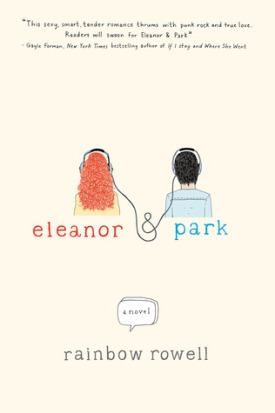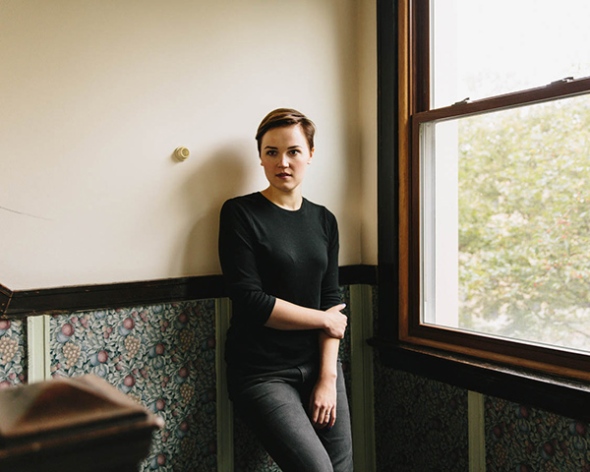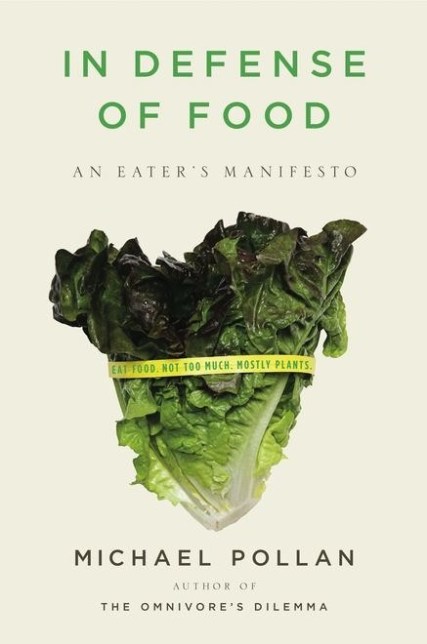Please click here to download my book talk info sheet and reflections about creating the talk.
Please click here to download my book talk info sheet and reflections about creating the talk.
 One my colleagues recently commented that she would love to hear the soundtrack to Rainbow Rowell’s novel (link here). I agreed with her, so I combed through the book for any musical references I could find.
One my colleagues recently commented that she would love to hear the soundtrack to Rainbow Rowell’s novel (link here). I agreed with her, so I combed through the book for any musical references I could find.
Park and Eleanor’s friendship begins when they start sharing songs and comic books. Musical references are all through the book. The first time I read the book, I skipped the title page and didn’t realize that it was set in 1986 — I just thought Park and Eleanor had really good taste (though really, regardless of the decade, they still have really good taste).
About halfway through making the playlist, I wondered if anyone else had had the same idea. Turns out, a lot of people have… including the author herself. Rainbow Rowell has a detailed post on her own blog on the songs that made the book come alive for her (click here). Posh Deluxe at Forever Young Adult also complied a great soundtrack (click here).
Eleanor and Park deals with first love and fledgling sexuality. It’s the best kind of romance, engrossing and intelligent. But Rowell also deals sensitively with racism, bullying, physical and sexual abuse. The characters are incredibly human and likeable. Rowell brings the 80s to life, vividly evoking the decade’s popular culture. The book is incredibly popular for a reason, and (unlike so many super popular books) I’m happy to say that those reasons include Rowell’s great writing and unforgettable characters.
In class last week, we learned about writing annotations. Working in groups, it was fascinating to hear the opinions of my peers and what they felt were the most important and compelling aspects of the book (My group worked with The Fault in Our Stars, by John Green). Writing in a group is always a neat experience; people approach language in such different ways. I thought it would be interesting to go through the process step-by-step on my own and see what kind of results I could produce.
We followed Mary K. Chelton’s guidelines, available here: http://www.sjrlc.org/rahandouts/annotation.htm. Chelton asks a series of questions about the book and then recommends you pare down your answers to a 35-50 word annotation. It’s also important not to give away the ending of the book!
Who is/are the significant other(s)? Hazel Grace, a 16 year old girl who is living with cancer
What is the setting?
Indianapolis
When does the story take place?
Present day
What is the character’s challenge?
Twofold: Hazel is dealing with her first romance and is desperate to discover the ending of her favourite book
What are the roadblocks to success?
Hazel is living with cancer
Annotation: Hazel’s shield of sarcastic wit is about to be penetrated by the boy of her dreams. Romantic and dramatic, together they will go on a journey to find discover the ending of Hazel’s favourite novel.
This exercise proved really difficult. After careful reflection, I’ve decided that my emphasis on the ending of the book is decidedly less significant if you don’t know how the book ends. Incorporating a ‘hook,’ as Chelton suggests, is difficult. Her questions do motivate you to think critically about the book and what was important about it.
But something feels so wrong about cutting John Green’s beautiful story down to only a sentence. It’s hard to convey the magic that his writing conveys in so few words. I can’t help but feel frustrated that such a short annotation, focusing on the facts of the novel, disregards all of the things that make the book truly special: the way Green doesn’t talk down to his audience, his excellent writing and quick references, his very raw portrayal of teenage anxieties, the way he doesn’t gloss over or romanticize the horrors of cancer or the tragedy of illness while still managing to be undeniably funny. It would take skill indeed to comb all that down into less than fifty words.

Photo by Ryan Lowery for Chicago Reader. Image from http://www.chicagoreader.com
Veronica Roth has experienced the kind of success that most writers only dream about. At 25, she is the best selling author of the Divergent trilogy, the first of which is being made into a movie this year. The first two books in her dystopian YA trilogy have been a great commercial success, making her one of the best selling authors in the world (link).
Roth graduated from Northwestern University with a degree in Creative Writing in 2010. The rights to the Divergent were sold before she completed her final semester. She was raised by her mother, painter Barabra Roth. Though Veronica was raised by her mother without religion, she became a devout Christian after attending a bible study in high school. She has spoken about having anxiety issues, saying that dealing with her mental health has greatly influenced the ideas that are present in her writing. For example, the premise for the Divergent trilogy was inspired by a psychology class and Roth’s interest in personality tests. In 2011 she married photographer Nelson Fitch. They currently live in Chicago.
Bibliography
Divergent (2011)
Insurgent (2012)
Allegiant (2013)
Free Four (e-book short released in 2012)
“Hearken” (2013), short story in the Shards and Ashes anthology.
Critical Reception
The trilogy’s concept, a dsytopian world where everyone is split into one of five groups based on personality traits, has been widely praised. The trilogy’s protagonist, Tris, has also been praised for her obvious shortcomings. A strong female character, Tris is flawed: she is selfish, vindictive, and sometimes manipulative, while still managing to be a likeable. Offering an explanation for the book’s wild success, Evan Daughtery praised Roth’s premise: “Veronica nailed a very primal, relatable idea: You turn 16 and you choose what you think is going to be some narrow version of how the rest of your life is going to look” (link). The trilogy is considered an easy and yet incredibly engrossing read; it is has been compared to potato chips.
Roth’s writing includes many hallmarks of recent popular YA lit: a female protagonist, gratuitous action and fight scenes, and a passionate yet chaste romance. In the third book, a love triangle is hinted at. While the romance is intense, the characters in Roth’s books have limited sexual experiences. When pressed, Roth says this was a conscious choice. It was important, she says, for her to not alienate her younger readers: “I didn’t want to have smut on the page. I don’t want to titillate” (link).
The third book in the trilogy has not had the same commercial success as the first two installments. Some critics felt that the ending to the series was “disappointing,” (link) while others contend that the ending was “pleasingly brave and poignant” (link). Roth’s fan base had a much stronger and more negative reaction to the third book: many readers felt betrayed by the ending. Less passionate criticism contended that the book simply fell flat after its long-awaited and highly publicized arrival.
List of awards
Goodreads Favourite Book of 2011
Goodreads Best Young Adult Science Fiction and Fantasy (2012)
Motivation & Practices
While in university, she worked hard and maintained good grades, but said that she always made sure to prioritize writing. Roth found that constantly juggling her life was difficult, and “didn’t always turn out well” (link). She also found that balancing work, school, and “being a person” (link) was a matter of using time effectively. Now that writing is her full time job, rather than a hobby, she has said that she is making an concerted effort to find new ways to occupy her time (link).
“I crammed DIVERGENT into the spaces between my classes. I woke up early to work on it, and I stayed up late. I worked on it rather than doing homework or studying for tests. I wrote DIVERGENT concurrently with my senior thesis. And I wrote it isolated from my academic community.”
When studying Creative Writing at Northwestern, Roth wrote Divergent in her spare time. She struggled with feeling ashamed of liking and writing YA lit, worrying that what she was working on was not intellectual enough. Roth has urged others to let go of feeling ashamed of reading and/or writing YA literature (link).
Roth maintains that she thrives with routine (link), and that taking time away from writing does not come easily for her, though she considered it an important part of the creative process. In 2010, she posted a reflection on her blog saying that spending some time “unwriting” (link) was just as important as consistently writing.
Since 2009, Roth has kept a well-maintained blog. She has posted extensively on her writing process, even providing screenshots of her revision process (link). She relies on checklists and colour coding to stay organized and likes to arrange (and complete tasks) in order of difficulty, beginning with the most difficult. Roth also uses lists to help outline her characters, keeping track of their goals and motivations to make sure that the characters are consistent and believable.
Related Media
Divergent is due out in 2014. Rights to the film were purchased by Summit Entertainment, the same production company behind the Twilight movies. Roth was adamant that she did not want to be a part of the movie process, saying that as a writer, she had no desire to make movies. She was very happy with the casting and sets. Shaliene Woodly has been cast as Tris, the female protagonist. Interestingly, Woodly also stars in the film adaptation of John Green’s The Fault in Our Stars. These intersections are a poignant reminder of how YA literature is marketed: book stores tend to stock and publicize a few popular authors, rather than a variety of different authors. Theo James and Kate Winslet also star in the film adaptation. Here is the movie trailer:
Veronica Roth answers fan’s questions live stream (medicated by New York Magazine)
Interesting Links
Veronica Roth’s personal blog, which she has maintained since 2009. Her posts are thoughtful and often confessional. She has posted extensively on the writing process. Interestingly, she has not updated her blog’s interface or transformed it into a fancy website, a touch that I personally find endearing and demonstrative of Roth’s uneasy relationship with fame.
Veronica Roth is the third most followed author on goodreads. Her profile can be accessed here: goodreads profile.
With a young fan base and an upcoming movie, tumblr is buzzing with news about Roth’s books. A search reveals the extent of her fans’ engagement: tumblr.
I love to read. Hopefully you do too! I’m excited to introduce a new series for my site: Recommended Reading. I plan to recommend books, articles, blogs and other writing that hopefully you will enjoy. It is my hope that I can use this site to foster discussion and further recommendations from fellow bibliophiles. Check out the books that I’m currently reading as well as past reviews in the drop down menu.
You can read my first recommendation, for Michael Pollan’s In Defense of Food by clicking here.
Pollan begins and ends his book by tell us how we should be eating. What he prescribes is a new manifesto for the way that we should eat:
Eat Food. Not Too Much. Mostly Plants.
Look closely, it’s wrapped around the lettuce on the cover of his book: 
I’ve really taken my time to read Michael Pollan’s fifth book, the #1 New York Times Bestseller, In Defense of Food: An Eater’s Manifesto. It’s full of information and a lot of it is hard to digest, if only because the facts he displays are terrifying.
Pollan’s introduces the book as a natural progression of his research from his 2006 novel, The Omnivore’s Dilemma, which elucidated the sins of the American food system. In Defense, Pollan purports, is a follow up that expounds on his earlier premise of what not to eat, but adds what we should be eating as well.
His research is dense and his evidence is alarming. Pollan himself owns that many of the scientific theories he examines may be reductionist. He admits that, in fact, what we do not know about nutrition is a great deal larger than what we do know. What I found most interesting (and most valid) about Pollan’s analysis of the Western diet is its roots in history. Even if we do not completely understand the science behind nutrition, we do understand that the Western diet is an epidemic. Examining the history behind our current habits is worthwhile, giving insight and understanding into the major influences and factors that lead us to where we are today.
The political and economic movements and pressures that lead to the Western diet as we know it are both terrifying and fascinating. What’s worse is that they are not common knowledge. As consumers (literally, as people who eat food) it is essential to understand the social, political and historical contexts that have shaped our current practices.
I couldn’t be happier that Alice Monro, a Canadian author and Western alumna, has just been awarded the Nobel Prize for Literature.

image from http://www.acs.aec.ca
Not familiar with Monro’s work? Now’s the time! I highly recommend A View from Castle Rock and Hateship, Friendship, Courtship, Loveship, Marriage.